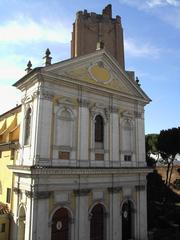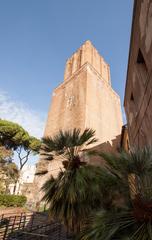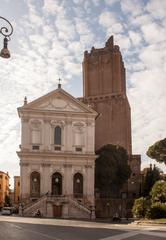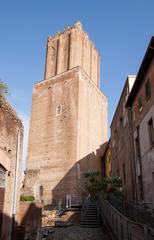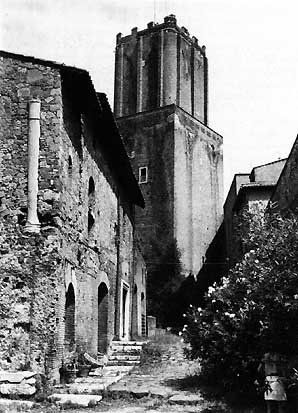
Torre delle Milizie Visiting Hours, Tickets, and Rome Historical Sites Guide
Date: 14/06/2025
Introduction to Torre delle Milizie and Its Historical Importance
The Torre delle Milizie—also known as the “Tower of the Militia”—is one of Rome’s most iconic medieval landmarks, offering visitors a fascinating glimpse into the city’s complex historical landscape. Strategically positioned between Trajan’s Market and the Imperial Fora on the Quirinal Hill, the tower exemplifies Romanesque military architecture and embodies the turbulent political and social dynamics of medieval Rome. Constructed in the early 13th century, likely by the influential Conti di Segni family during Pope Innocent III’s papacy, the tower has witnessed centuries of power struggles, warfare, and urban transformation. Its distinctive lean, resulting from the devastating 1348 earthquake, has earned it the nickname “Rome’s leaning tower.” The robust brick and tuff construction reflects the adaptive reuse of ancient Roman materials, seamlessly linking Rome’s imperial past with its medieval present (Turismo Roma; Wikipedia; colosseumrometickets.com).
Today, the Torre delle Milizie stands not only as an architectural marvel but also as a testament to Rome’s layered cultural and historical significance. Historically, it served as a stronghold for influential families such as the Conti, Annibaldi, and Caetani, played a role in significant events like Henry VII of Luxembourg’s coronation, and even inspired artistic works, including those of Giotto. This guide provides comprehensive and up-to-date visiting information—including current access restrictions, ticketing, accessibility, and travel tips—to help you plan a rewarding visit to this extraordinary Roman monument (Turismo Roma; Rome Art Lover).
Table of Contents
- Introduction
- Historical Overview
- Architectural Features
- Restoration and Preservation
- Visiting Information
- Nearby Attractions
- Frequently Asked Questions (FAQ)
- Cultural Legacy and Modern Significance
- Visuals and Media Recommendations
- Conclusion
- Further Reading and Related Articles
Historical Overview
Origins and Medieval Context
The Torre delle Milizie’s construction is traced to the early 13th century, during a period marked by intense political strife among Rome’s noble families. While legends associate the tower with Emperor Nero, historical evidence indicates it was erected much later, most likely by the Conti di Segni family during Pope Innocent III’s reign (Turismo Roma). The name “Torre delle Milizie” refers to its association with the city militias, possibly the “militiae Tiberinae” or later medieval forces.
Political Significance and Ownership
Throughout its history, the Torre delle Milizie served as a symbol of power, passing through the hands of prominent families such as the Annibaldi, Prefetti di Vico, and Caetani, before returning to the Conti and eventually being acquired by the nuns of Santa Caterina a Magnanapoli in 1619. The tower’s strategic importance was highlighted during events like Henry VII of Luxembourg’s coronation, when it was used as a base by Ghibelline supporters (Wikipedia).
Architectural Features
Structural Layout and Dimensions
The tower is a quintessential example of Romanesque military architecture. Built on a square base of approximately 10.5 by 9.5 meters, it originally stood taller than its current 50 meters due to the 1348 earthquake, which led to the loss of its uppermost levels (colosseumrometickets.com). The structure comprises three tapering sections designed for stability and defense.
Building Materials and Construction Techniques
Constructed primarily of tuff and brick, the Torre delle Milizie demonstrates the medieval practice of reusing materials from ancient Roman structures. The thick masonry walls—up to 2.5 meters at the base—provided both defense and durability, and the tower’s verticality allowed for effective surveillance of the surrounding area (Wikipedia).
Defensive Features
The tower’s limited windows and elevated entrance—accessible only by ladder or staircase—reflect its defensive function. Its height enabled communication with other fortifications and provided a vantage point to monitor the approaches to the city (colosseumrometickets.com).
Integration with Trajan’s Market and Urban Setting
The Torre delle Milizie was integral to a larger fortified complex, including palaces and walls near Trajan’s Market and the Imperial Fora. This integration is still visible in the archaeological landscape, offering a tangible connection between Rome’s ancient and medieval eras (Turismo Roma).
Restoration and Preservation
Declared an Italian National Monument in 1911, the Torre delle Milizie has undergone several major restoration efforts, including the separation from the adjacent convent of Santa Caterina in 1914. These measures aimed to stabilize the structure and preserve its historical integrity for future generations (Wikipedia). Ongoing conservation ensures the tower remains a significant feature of Rome’s architectural heritage.
Visiting Information
Visiting Hours and Tickets
As of June 2025, the Torre delle Milizie is closed to the public for preservation. When open, entry is typically included with a ticket to Trajan’s Markets or the Museo dei Fori Imperiali. Standard tickets cost around €12–15 for adults, with discounts for EU citizens under 25 and free entry for children under 18. Always check the official Turismo Roma website or Museo dei Fori Imperiali site for up-to-date hours and ticketing information.
Accessibility
Due to its medieval structure and narrow staircases, the tower’s interior is not fully accessible to those with mobility challenges. However, parts of the museum and surrounding archaeological area are accessible, so visitors with reduced mobility can still enjoy much of the historic setting.
Guided Tours and Special Events
Special guided tours are occasionally offered, often in combination with Trajan’s Market and the Imperial Fora. These tours provide deeper historical insight and, when available, may grant access to areas not open to standard visitors.
Travel Tips
- Best Time to Visit: Early morning or late afternoon for optimal lighting and fewer crowds, particularly in summer months (romeactually.com).
- What to Wear: Comfortable shoes are recommended due to uneven pavements and staircases. In summer, dress lightly and bring sun protection.
- Nearby Transport: The site is accessible via Metro Line B (Colosseo or Cavour stations) and several bus lines.
Nearby Attractions
The Torre delle Milizie is ideally situated for exploring other key historical sites in Rome, including:
- Trajan’s Market
- Imperial Fora
- Roman Forum
- Palatine Hill
- Colosseum
- Piazza Venezia
These sites collectively offer an immersive exploration of both ancient and medieval Rome.
Frequently Asked Questions (FAQ)
Q: Is the Torre delle Milizie currently open to visitors?
A: As of June 2025, the tower is closed for preservation. Check official sites for reopening updates.
Q: Where can I buy tickets?
A: Tickets, when available, are included with Trajan’s Markets or Museo dei Fori Imperiali admissions, sold online or at official ticket offices.
Q: Is the tower accessible for people with disabilities?
A: Due to its historic structure, interior accessibility is limited. The surrounding museum is partially accessible.
Q: Are guided tours available?
A: Yes, many local operators and the museum itself offer guided tours, often including exclusive insights into the tower’s history.
Q: What are the best times for photography?
A: Early morning and late afternoon offer the best natural light and fewer crowds.
Cultural Legacy and Modern Significance
The Torre delle Milizie stands as a rare and well-preserved example of medieval military architecture in Rome, more often famed for its ancient and Renaissance monuments. Its silhouette remains a powerful symbol in the city’s skyline, and its history is deeply woven into Rome’s narrative of resilience and adaptation (worldhistoryedu.com). The site continues to inspire research, education, and artistic appreciation.
Visuals and Media Recommendations
Enhance your planning and anticipation by exploring:
- High-quality images: Views of the Torre delle Milizie’s facade, and panoramic shots from the upper levels (when accessible), highlight its distinctive architecture.
- Interactive maps: Locate the tower in relation to Trajan’s Market and the Imperial Fora for context.
- Virtual tours: Many official tourism platforms offer 360-degree experiences of the site.
Image suggestions:
- Torre delle Milizie leaning view from Quirinal Hill (alt: “Torre delle Milizie leaning tower Rome view”)
- Trajan’s Market archaeological complex with Torre delle Milizie (alt: “Trajan’s Market and Torre delle Milizie medieval tower”)
- Historical map of Rome with Torre delle Milizie location (alt: “Historical map of Rome with Torre delle Milizie”)
Conclusion
The Torre delle Milizie offers a compelling journey through Rome’s medieval past, blending architectural intrigue with rich historical narrative. Whether you are a history enthusiast or a curious traveler, this landmark provides a unique window into the city’s evolution from imperial grandeur to medieval resilience. While the tower is currently closed, its reopening will provide further opportunities for exploration and discovery. Plan ahead, stay updated through official resources, and consider guided tours or digital tools like the Audiala app to enrich your experience of Rome’s historical treasures.

